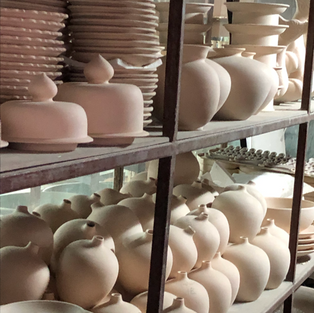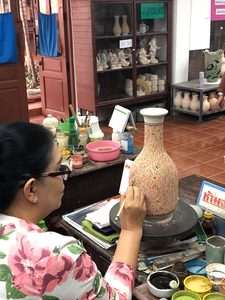On our third day in Chiang Mai we went on a tour of several establishments where they make traditional Thai arts and crafts with the most amazing attention to detail. We have seen some lovely pieces of wood carving and gilt statues at Thai restaurants in the States and marveled at their intricacy so it was fascinating to see the processes behind the work.
Ceramics
The first stop was a ceramics factory where men were throwing dishes and pots on wheels.

Some women were carving designs into the wet pots before they were dried and fired. Ceramic elephants were also hand carved.
Everywhere there were stacks of dishes, pots, and elephants ready for painting and glazing.
Watching the women hand painting some vases was absolutely mesmerizing. Every line, every flourish was carefully and delicately applied. These women were free to develop their own designs -- some of them were quite traditional and some of them were using traditional motifs with a modern twist.
Once they were painted, they were fired again and looked so gorgeous.

We couldn’t resist buying a small vase that they packaged and shipped home for us, which they said would take 2 or 3 months -- just in time for us to get home. It was fun to unwrap it.

Silk Fabric
Our next stop was a silk shop where they start from scratch, raising the little silkworm critters in trays until they produce their cocoons.
Then they boil the cocoons (with the poor little critters inside) and separate the fibers onto a spinning wheel. However, they do save some cocoons for hatching, laying eggs and continuing the process.
Like the weavers in Guatemala and Peru , they use various plants and minerals to produce natural dyes and boil the silk fibers in the dye pots.
In the background is the click-clacking of the weaving looms, where the women create beautiful patterns with the vibrant colors. It is hard to understand how the looms work — their hands and feet move so fast.
Around the sides of the room, there were displays showing the traditional clothing designs of the various tribes in the area -- some of these we had seen at the dance performance two days before..
I would have bought yards and yards of cloth if we had luggage room but I restricted myself to the tiniest kerchief they had with a beautiful flower on it.
Lacquerware
From my own excursions into pottery making and weaving in my younger days, I had some familiarity with the processes used for making the ceramics and the silk cloth, but I had no notion of what goes into the making of the black lacquerware they use to decorate dishes, furniture and animal figures. The lacquer is the gooey resin from the lacquer tree and it is applied in layers to achieve a smooth, glossy finish that is then decorated in a variety of ways. Our guide here showed us the difference between cheap versions often sold to tourists on the street that only have one or two layers of lacquer and their product that is covered with at least seven layers — quite a difference!

One traditional decorating method is to apply gold leaf, as this woman is doing on the elephant figurines.

They also use engraving and hand painting techniques. But we were most fascinated by the mosaics they do with egg shells. Watching a craftsman at work using this technique made us realize just what a painstaking process it is. He would break the shell into tiny pieces, then choose the one with just the right shape for his design and glue it in place — one tiny piece after another.
So much patience!!!
Wood Carving
The wood carving shop was David’s favorite. We were able to watch as men - and women we were happy to see - worked on their masterpieces. A large carving can take several months to complete. We watched as they chiseled away little bits to make these amazing scenes.
Here are some finished pieces.
We really loved them, but they were heavy and would cost a fortune to ship I think.
Paper Parasols
Like all their crafts, they start from scratch making the paper for the parasols by screening out fiber from big vats. They make the frames from bamboo slats and then apply the paper in layers. Then the parasols are hand painted in beautiful designs of flowers and birds.
After that, it was hot, we were tired, and there was an air-conditioned coffee shop nearby. Iced lattes — yessss!!!!!






















































Comentarios